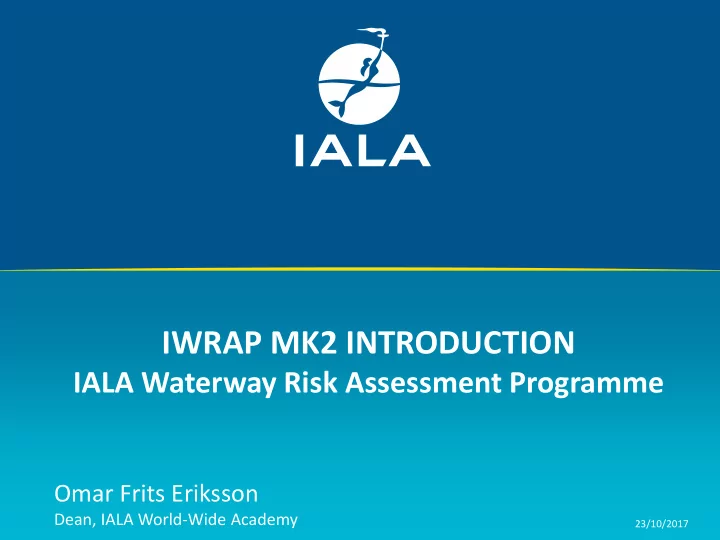

IWRAP MK2 INTRODUCTION IALA Waterway Risk Assessment Programme Omar Frits Eriksson Dean, IALA World-Wide Academy 23/10/2017
Not Rocket Science
IWRAP is Probabilistic algorithm Scenario based Quantitative approach
1974 Fujii, et al. “Some Factors Affecting the Frequency of Accidents in Marine Traffic.” Journal of Navigation, Vol. 27, 1974 MacDuff, T.: “The Probability of Vessel Collisions”. Ocean Industry, September 1974.
1995 Pedersen, P. Terndrup: "Collision and Grounding Mechanics". Proc. WEMT 1995, Copenhagen
IWRAP Evolution IALA Council Approves ”IWRAP Mk I” (2006) Copenhagen calibration test failure (2006) SG decides to start from scratch (2007) New software coding by Gatehouse (2008) Commercial version available (2010) IWRAP Mk2 V/5 Release (China 2017)
IWRAP Mk2 Licensing scheme Basic License (free to IALA members) Commercial License
IWRAP is a Probabilistic algorithm
Basic Risk Equation R = P ∙ C R = Risk P = Probability that undesired incident occurs C = Consequences of undesired incident
IWRAP ….. Probability / Frequency R = P ∙ C
IWRAP basic algorithm 1. First determine the (average) number of possible incidents, assuming that no evasive action is taken (blind navigation). 2. Then adjust this number by multiplying it with the probability that an evasive action fails (thinning with Fujii type causation factors)
Basic Algorithm X Gnd = N Gnd ∙ P C N Gnd = Number of Grounding Candidates P c = Causation Probability X Gnd = Number of Annual Groundings
Grounding scenario Number of grounding candidates is proportional to the portional area under the curve times traffic volume (COWI Consult , 2006)
Lateral Distribution of Vessels from AIS
Assumptions 1. Geometric distribution of the ship traffic over the waterway is constant 2. Volume of traffic is constant 3. Composition of traffic is constant 4. Lateral distribution of vessels is constant 5. Causation factors are constant 6. ….. 7. …..
Causation Factors
Elements of Causation Probability Factors ”Human Factors”
Elements of Causation Probability Factors ”Organisational/Structural”
From litterature we have
IWRAP Default Causation Probabilities
IWRAP is Scenario based Grounding scenarios (2) • Allission Scenarios (2) • Collision Scenarios (6) •
Grounding & Allision Scenarios Powered grounding / allision Drifting grounding / allision
Powered grounding Number of grounding candidates is proportional to the portional area under the curve times traffic volume (COWI Consult , 2006)
Powered Grounding Analyst can set/adjust: Causation factor value For each ship type, what is the probability that the navigatior fails to make an evasive action.
Drifting Grounding Analyst can set/adjust: blackout frequency repair time probabilities ancoring probability and conditions drifting direction probability
Drifting grounding Repair time probability
Scenarios - Collisions Overtaking collisions Head –On collisions Crossing collisions Merging collisions Bend collisions Area collisions
Collisions scenarios Analyst can set/adjust: • Causation factor values For each ship type, what is the probability that the navigatior fails to make an evasive action.
Area collision scenario Can model non-AIS vessels Fishing vessel behaviour Leisure vessel behaviour Analyst can modify causation factor for each ship type
Causation factors IALA default values
Model Calibration Compare with Model based on Calibration Historical present traffic distribution Casualty data and waterway geometry Verification Results: Run Collision/ IWRAP Mk2 Grounding frequencies
Basic Procedures Define area to be analysed Gather sea charts, incident data Define route layout / route legs Allocate traffic to route legs Define relevant grounds as polygons Do calculation Calibrate model What-if analysis
Share results with IALA
Data requirements for IWRAP Analysis: High or medium resolution AIS data Sea charts Grounding hazard information Historical facts on incident (Causation Factor adjustments)
Stable conditions? Incident data is historical (you want 10 years) Have the conditions changed in this period? New aids to navigation? Has volume of traffic changed? Has the traffic composition changed?
AIS data quality Gaps in time series? Blind spots in geographic coverage? Has the data been downsampled?
Gaps in AIS data
AIS coverage quality
Downsampled AIS data
Downsampled AIS data
Incident data quality Need data for calibrating your model Groundings – often to few registred Collisions – usually good Types of incidents? Positions of incidents? Types of vessels involved?
Causation Factors IWRAP provides default values Significant variation globally Analysts need to form their own view Need to exchange these views
Analysts and their quality Understand the limitations of IWRAP Understand the waterway conditions Understand waterway history Understand Causation Factors
Risk Toolbox Wiki http://www.iala-aism.org/wiki/iwrap/
Thanks
Connect: E-mail: omar.eriksson@iala-aism.org LinkedIn: Omar Frits Eriksson Twitter: OMaritime Mobile: +33 6 31 17 76 42
Recommend
More recommend